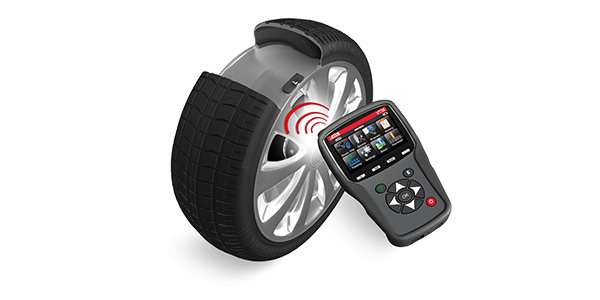With the right TPMS tools and knowledge, TPMS relearn procedures can be easy to service, but there are some vehicles that are more challenging than others when it comes to relearn procedures.
When a service has been performed to the direct TPMS system such as air pressure adjustment, tire rotation or replacement of sensors, most vehicles will require a TPMS system relearn be performed. Relearn procedures vary by manufacturer, so a technician must know if a relearn procedure is necessary to put the vehicle in “learn” mode.
The three types of relearn procedures are auto relearn, stationary (manual) and OBD. Some vehicles may use a combination of two or more relearn types. Indirect TPMS systems use an initialization procedure which may require a TPMS tool to figure out the steps involved to reset the system.
The TPMS relearn process is created by the vehicle manufacturer, and follows a series of steps. By using the correct relearn procedure steps, the entire TPMS system will be in working order again. However, failing to perform a complete TPMS relearn procedure can result in failure of tire pressure readings and failure as well as tire pressure monitoring system failure.
The list below describes the most difficult vehicles to date to perform relearns and tips on how to resolve the issues based on customer phone calls and emails, provided by the ATEQ TPMS Tools technical support team.
Relearn Challenge 1: Toyota and Lexus
When Toyota and Lexus require an OBD relearn procedure, an advanced TPMS diagnostic scan tool is required to perform it. Here are the steps to the OBD relearn procedure for 2009 Toyota Corolla:
Step 1: Inflate all tires
Step 2: Read all sensor IDs using tool
Step 3: Connect tool to OBDII port
Step 4: Reset ECU with tool
Step 5: Ignition OFF then ON
Step 6: Drive at 12 MPH for up to 5 mins
Sometimes, the relearn procedure fails even after the steps are properly performed because of the SET button, which is located below the steering wheel or in the glove box in some Toyota models. When the button is pressed, the system tries to locate the sensor IDs that are already stored. The SET button can be used when performing a tire rotation when the fitment has different tire pressures in the front and rear, changing or adjusting the tire pressure, or when changing tire size or when tires are replaced. However, when replacing a sensor or installing a second set of wheels, an OBD relearn must be performed. The OBDII module connection will program the new sensor ID numbers into the vehicle’s ECU. Then, the relearn procedure can be performed.
If the SET button is pushed and a relearn must be performed, the ECU must be unlocked in order for the relearn procedure to work correctly. An advanced TPMS scan tool often has an UNLOCK ECU button under the service TPMS menu that can help turn the button OFF. After using the UNLOCK ECU option within the tool, the relearn procedure can be properly performed using the relearn procedure steps that are explained within the tool.
Relearn Challenge 2:
Ford Vehicles with a Push-Button Start
Ford vehicles require a stationary (manual) or auto TPMS relearn procedure. Here are the steps and troubleshooting tips for a manual relearn procedure for 2010 Ford F-Series with push-button start:
Step 1: Engage the parking brake and inflate all tires
Step 2:
With the vehicle turned OFF, push and release the brake pedal
Step 3: Push the START button 5 times
Step 4: Press and release the brake pedal
Step 5: Push the START button 6 times
Step 6:
A single horn chirp will indicate the relearn mode is active
Step 7: Use a tool to activate LF sensor
Step 8:
A single horn chirp will indicate that the sensor learning was successful
Step 9: Repeat for RF/RR/LR tires
Step 10:
TRAINING MODE COMPLETE will display on message center when the relearn is finished.
Troubleshooting: If the TPMS system does not reset after correctly performing all steps, there could be an interference issue with the sensor and vehicle’s ECU, especially for the larger trucks such as the F-Series. If the sound doesn’t chirp during step 6 or 8, that means the relearn procedure did not work. Try the following tips from our TPMS technical support team:
•
Lower all windows, turn off the radio and open the doors. Try the relearn procedure again.
•
Back up vehicle 6-8 inches, then try the relearn procedure again.
Some Ford models require the start button to be pressed 2x (without pressing the brake) to enter RUN mode (Ignition ON/Engine OFF). If that is the case, modify the relearn procedure as follows:
Step 3: Push start button 8 times
Step 5: Push start button 9 times
Relearn Challenge 3:
Buick Manual Relearn Procedures
The Buick vehicle requires a manual or OBD relearn, and only a few advanced TPMS diagnostic scan tools have the correct protocols required to perform it. The OBD relearn procedure has many advantages since there are a significant number of steps with the manual relearn, which can cause too much time for technicians. Most shops who service tires frequently carry an advanced TPMS diagnostic scan tool to skip the complicated manual relearn procedures for the OBD protocols for certain vehicles.
2014 Buick Regal with Keyless Entry:
Step 1: Inflate all tires
Step 2: Turn the ignition ON
Step 3:
Push and hold the unlock and lock button on the key fob until horn sounds
Step 4: Use a tool to activate the LF sensor
Step 5: A single horn will sound
Step 6: Repeat for RF/RR/LR tires
Step 7: Turn the ignition OFF
2014 Buick Regal with DIC button:
Step 1: Inflate all tires
Step 2: Apply the parking brake
Step 3: Turn the ignition ON
Step 4:
Push the DIC information button until PRESS TIRE LEARN display
Step 5: Push the “tire symbol” to confirm
Step 6:
The horn sounds 2x and TIRE LEARNING ACTIVE is displayed
Step 7: Use tool to activate LF sensor
Step 8: A single horn sounds
Step 9: Repeat for RF/RR/LR tires
Step 10: Turn ignition OFF
Step 11: Release parking brake before driving vehicle
2014 Buick Regal with odometer reset:
Step 1: Inflate all tires
Step 2: Apply the parking brake
Step 3: Turn the ignition ON
Step 4:
Push and hold the trip odometer reset stem on instrument panel until PRESS “tire symbol” TO RELEARN TIRE POSITIONS is displayed
Step 5: Push the “tire symbol” to confirm
Step 6:
Horn will sound 2x and TIRE LEARNING ACTIVE is displayed
Step 7: Use tool to activate LF sensor
Step 8: A single horn sounds
Step 9: Repeat RF/RR/LR tires
Step 10: Turn ignition OFF
Step 11: Release parking brake before driving vehicle
As shown above, the relearn procedures are seven to eleven steps, but the OBD relearn procedure is only five steps, saving the technician’s time on jobs performed.
OBD relearn for a 2014 Buick Regal:
Step 1: Inflate all tires
Step 2: Read all sensor IDs using the tool
Step 3: Connect the tool to OBDII port
Step 4: Reset the ECU with tool
Step 5: Drive for at least 28 minutes at 28 MPH. TR
Contributing Writer Sheila Stevens is with ATEQ TPMS, LLC, a global manufacturer of TPMS diagnostic tools and solutions. For more information on ATEQ’s line of TPMS tools and solutions, as well as additional information on TPMS, visit www.ateq-tpms.com.













